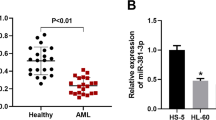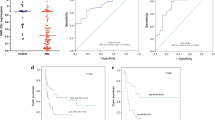Abstract
Purpose
Abnormal expression of miRNAs is intimately related to a variety of human cancers. The purpose of this study is to confirm the expression of miR-181a and elucidate its physiological function and mechanism in pediatric acute myeloid leukemia (AML).
Methods
Pediatric AML patients and healthy controls were enrolled, and the expression of miR-181a and ataxia telangiectasia mutated (ATM) in tissues were examined using quantitative PCR. Moreover, cell proliferation and cell cycle were evaluated in several cell lines (HL60, NB4 and K562) by using flow cytometry after transfected with miR-181a mimics and inhibitors, or ATM siRNA and control siRNA. Finally, ATM as the potential target protein of miR-181a was examined.
Results
We found that miR-181a was significantly increased in pediatric AML, which showed an inverse association with ATM expression. Overexpressed miR-181a in cell lines significantly enhanced cell proliferation, as well as increased the ratio of S-phase cells by miR-181a mimics transfection in vitro. Luciferase activity of the reporter construct identified ATM as the direct molecular target of miR-181a. ATM siRNA transfection significantly enhanced cell proliferation and increased the ratio of S-phase cells in vitro.
Conclusion
The results revealed novel mechanism through which miR-181a regulates G1/S transition and cell proliferation in pediatric AML by regulating the tumor suppressor ATM, providing insights into the molecular mechanism in pediatric AML.





Similar content being viewed by others

References
Bai H, Cao Z, Deng C, Zhou L, Wang C (2012) miR-181a sensitizes resistant leukaemia HL-60/Ara-C cells to Ara-C by inducing apoptosis. J Cancer Res Clin Oncol 138(4):595–602
Bartel DP (2004) MicroRNAs: genomics, biogenesis, mechanism, and function. Cell 116:281–297
Bisso A, Faleschini M, Zampa F, Capaci V, De Santa J et al (2013) Oncogenic miR-181a-5p/b affect the DNA damage response in aggressive breast cancer. Cell Cycle 12:1679–1687
Cai J, Guan H, Fang L, Yang Y, Zhu X et al (2013) MicroRNA-374a activates Wnt/β-catenin signaling to promote breast cancer metastasis. J Clin Invest 123:566–579
Chen CZ (2005) MicroRNAs as oncogenes and tumor suppressors. N Engl J Med 353:1768–1771
Chen CZ, Li L, Lodish HF, Bartel DP (2004) MicroRNAs modulate hematopoietic lineage differentiation. Science 303:83–86
Choong ML, Yang HH, McNiece I (2007) MicroRNA expression profiling during human cord blood-derived CD34 cell erythropoiesis. Exp Hematol 35:551–564
Cichocki F, Felices M, McCullar V, Presnell SR, Al-Attar A et al (2011) Cutting edge: microRNA-181 promotes human NK cell development by regulating Notch signaling. J Immunol 187:6171–6175
Debernardi S, Skoulakis S, Molloy G, Chaplin T, Dixon-Mclver A et al (2007) MicroRNA miR-181a-5p correlates with morphological sub-class of acute myeloid leukaemia and the expression of its target genes in global genome-wide analysis. Leukemia 21(5):912–916
Ell B, Mercatali L, Ibrahim T, Campbell N, Schwarzenbach H et al (2013) Tumor-induced osteoclast miRNA changes as regulators and biomarkers of osteolytic bone metastasis. Cancer Cell 24:542–556
Esquela-Kerscher A, Slack FJ (2006) Oncomirs—microRNAs with a role in cancer. Nat Rev Cancer 6:259–269
Estey E, Döhner H (2006) Acute myeloid leukaemia. Lancet 368:1894–1907
Huang G, Nishimoto K, Zhou Z, Hughes D, Kleinerman ES (2012) MiR-20a encoded by the miR-17-92 cluster increases the metastatic potential of osteosarcoma cells by regulating FAS expression. Cancer Res 72:908–916
Iliopoulos D, Jaeger SA, Hirsch HA, Bulyk ML, Struhl K (2010) STAT3 activation of miR-21 and miR-181b-1 via PTEN and CYLD are part of the epigenetic switch linking inflammation to cancer. Mol Cell 39:493–506
Kastan MB, Bartek J (2004) Cell-cycle checkpoints and cancer. Nature 432:316–323
Kastan MB, Lim DS (2000) The many substrates and functions of ATM. Nat Rev Mol Cell Biol 1:179–186
Li QJ, Chau J, Ebert PJ, Sylvester G, Min H et al (2007) miR-181a-5p is an intrinsic modulator of T cell sensitivity and selection. Cell 129:147–161
Li H, Hui L, Xu W (2012a) miR-181a sensitizes a multidrug-resistant leukemia cell line K562/A02 to daunorubicin by targeting BCL-2. Acta Biochim Biophys Sin (Shanghai) 44(3):269–277
Li X, Zhang J, Gao L, McClellan S, Finan MA et al (2012b) miR-181 mediates cell differentiation by interrupting the Lin28 and let-7 feedback circuit. Cell Death Differ 19:378–386
Li Z, Huang H, Li Y, Jiang X, Chen P et al (2012c) Up-regulation of a HOXA-PBX3 homeobox-gene signature following down-regulation of miR-181 is associated with adverse prognosis in patients with cytogenetically abnormal AML. Blood 119(10):2314–2324
Löwenberg B, Downing JR, Burnett A (1999) Acute myeloid leukemia. N Engl J Med 341:1051–1062
Marcucci G, Radmacher MD, Maharry K, Mrózek K, Ruppert AS et al (2008) MicroRNA expression in cytogenetically normal acute myeloid leukemia. N Engl J Med 358(18):1919–1928
O’Connell RM, Zhao JL, Rao DS (2011) MicroRNA function in myeloid biology. Blood 118:2960–2969
Ouyang YB, Lu Y, Yue S, Giffard RG (2012) miR-181 targets multiple Bcl-2 family members and influences apoptosis and mitochondrial function in astrocytes. Mitochondrion 12:213–219
Pichiorri F, Suh SS, Ladetto M, Kuehl M, Palumbo T et al (2008) MicroRNAs regulate critical genes associated with multiple myeloma pathogenesis. Proc Natl Acad Sci USA 105:12885–12890
Pons A, Nomdedeu B, Navarro A, Gaya A, Gel B et al (2009) Hematopoiesis-related microRNA expression in myelodysplastic syndromes. Leuk Lymphoma 50:1854–1859
Schwind S, Maharry K, Radmacher MD, Mrózek K, Holland KB et al (2010) Prognostic significance of expression of a single microRNA, miR-181a, in cytogenetically normal acute myeloid leukemia: a Cancer and Leukemia Group B study. J Clin Oncol 28(36):5257–5264
Shi L, Cheng Z, Zhang J, Li R, Zhao P et al (2008) Hsa-miR-181a-5p and hsa-mir-181b function as tumor suppressors in human glioma cells. Brain Res 1236:185–193
Shin KH, Bae SD, Hong HS, Kim RH, Kang MK et al (2011) miR-181a-5p shows tumor suppressive effect against oral squamous cell carcinoma cells by downregulating K-ras. Biochem Biophys Res Commun 404:896–902
Taylor MA, Sossey-Alaoui K, Thompson CL, Danielpour D, Schiemann WP (2013) TGF-β upregulates miR-181a-5p expression to promote breast cancer metastasis. J Clin Invest 123:150–163
Ventura A, Jacks T (2009) MicroRNAs and cancer: short RNAs go a long way. Cell 136:586–591
Wang X, Gocek E, Liu CG, Studzinski GP (2009) MicroRNAs181 regulate the expression of p27Kip1 in human myeloid leukemia cells induced to differentiate by 1,25-dihydroxyvitamin D3. Cell Cycle 8:736–741
Wang B, Hsu SH, Majumder S, Kutay H, Huang W et al (2010) TGFbeta-mediated upregulation of hepatic miR-181b promotes hepatocarcinogenesis by targeting TIMP3. Oncogene 29:1787–1797
Yang H, Cho ME, Li TW, Peng H, Ko KS et al (2013) MicroRNAs regulate methionine adenosyltransferase 1A expression in hepatocellular carcinoma. J Clin Invest 123:285–298
Zhai XF, Fang FF, Liu Q, Meng YB, Guo YY et al (2013) miR-181a-5p contributes to bufalin-induced apoptosis in PC-3 prostate cancer cells. BMC Complement Altern Med 13:325
Zhang H, Luo XQ, Zhang P, Huang LB, Zheng YS et al (2009) MicroRNA patterns associated with clinical prognostic parameters and CNS relapse prediction in pediatric acute leukemia. PLoS One 4(11):e7826
Zhuang LK, Xu GP, Pan XR, Lou YJ, Zou QP et al (2014) MicroRNA-181a-mediated downregulation of AC9 protein decreases intracellular cAMP level and inhibits ATRA-induced APL cell differentiation. Cell Death Dis 5(4):e1161
Acknowledgments
This work was supported by National Nature and Science Grant of China (81272310).
Conflict of interest
The authors declare that they have no conflict of interest.
Author information
Authors and Affiliations
Corresponding author
Additional information
Xiaodan Liu, Wang Liao and Hongxia Peng authors have contributed equally to the study.
Electronic supplementary material
Below is the link to the electronic supplementary material.
Supplement Fig. 1
The relationship of miR-181a expression and prognosis in 27 AML patients with complete follow-up data. a miR-181a expression in patients who achieved a complete remission versus patients who developed distant relapse or death. b Relapse-free survival according to miR-181a expression levels in pediatric AML patients with high (above the median miR-181a expression value) or low (at or below the median miR-181a expression value) expression groups. Statistical differences between curves were calculated using the log-rank test (TIFF 10822 kb)
Supplement Table 1
Characteristics of pediatric AML patients (N = 57) (DOCX 17 kb)
Supplement Table 2
Primers and other oligonucleotides sequences (DOCX 14 kb)
Rights and permissions
About this article
Cite this article
Liu, X., Liao, W., Peng, H. et al. miR-181a promotes G1/S transition and cell proliferation in pediatric acute myeloid leukemia by targeting ATM. J Cancer Res Clin Oncol 142, 77–87 (2016). https://doi.org/10.1007/s00432-015-1995-1
Received:
Accepted:
Published:
Issue Date:
DOI: https://doi.org/10.1007/s00432-015-1995-1



